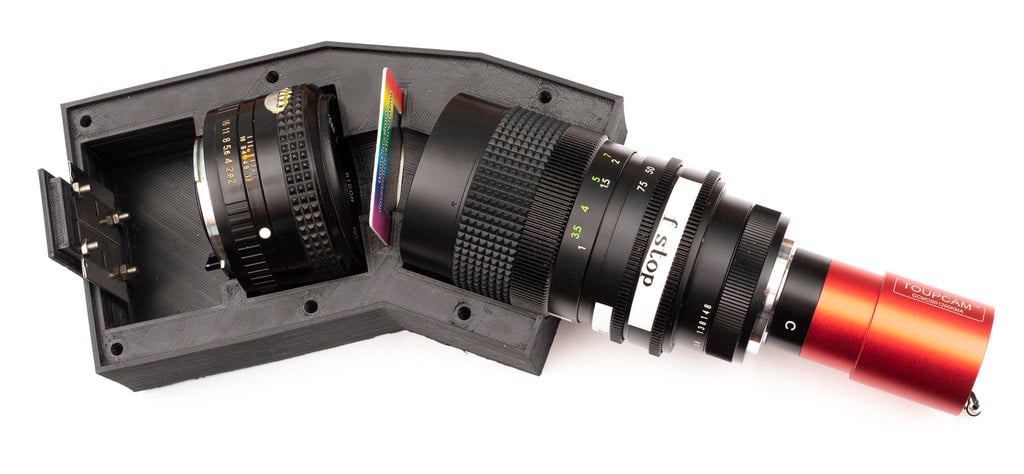
DIY spectroscope (spectrometer)
thingiverse
A DIY spectroscope of my design. The design is fully parametric (in Autodesk Fusion). I am using these two particular lenses I happened to have (but you can use many other lenses, just need to change parameters in the Fusion file - and the whole 3d design will adjust, and shrink or expand as needed): - Collimator lens: an old SLR 50mm f/2.0 lens by Ricoh - Camera lens: a C-mount 12.5-75mm f1.2 zoom lens (https://www.bhphotovideo.com/c/product/889132-REG/computar_M6Z1212_3S_2_3_12_5_to.html); I am using it at the widest end (12.5mm), so you don't really need a zoom lens. It just needs to be fairly fast, and very importantly - should have a focusing ring. An aperture ring would be useful, but not a must. My camera is a cheap B&W C-mount astrocamera ToupTek, but many other types (DSLR etc) can be used. You can even use a webcam with a built-in lens (so no camera lens is needed), but that would require some redesigning. Generally speaking, B&W cameras are preferable as they don't introduce debayering artifacts. Astro cameras are better because they have high dynamic range and color depth (12 bit in my case). For the diffraction grating, I'm using a cheap 1000 l/mm slide-style grating available from school supplies etc. I got one from ebay for 5$ (https://www.ebay.com/itm/Diffraction-Grating-Slide-Holographic-Linear-1000-lines-mm-Lamp-Laser-Spectrum/270818868831). For the slit, I am using a couple of Razor Scraper Replacement Blades (https://www.canadiantire.ca/en/pdp/razor-scraper-replacement-blades-5-pk-0496552p.html), you'll have to redesign the model for other kinds of blades. The only other parts used were 6 long (45 mm, excluding head; will need another length if you use other lenses) M4 screws with washers and nuts (for the enclosure), and 4 cone-head M3 screws with nuts (for the slit). All math derivations are from this site: https://ibsen.com/technology/spectrometer-design-guide/ For calibration, it is very convenient to use an old CFL (fluorescent) bulb, which has ~20 of easily identifiable emission lines covering the whole visible spectrum (https://commons.wikimedia.org/wiki/File:Fluorescent_lighting_spectrum_peaks_labelled.gif). Once fully calibrated, my spectrometer is pretty accurate - the standard deviation for the 18 CFL bulb lines is only 0.35 nm (see the plot attached - blue curve is my measured spectrum of the bulb, vertical red lines - actual wavelengths of the 18 spectral lines). I use a slightly non-linear (parabolic) calibration, to go from the pixel coordinate to the wavelength. The resolution is under 2nm. A more narrow slit would produce a higher resolution, but you'll loose light. (I set my slit to ~ 0.1mm gap). A very useful addition was a DIY metal plate with a standard 1/4" threaded hole, to make the spectroscope mountable on a tripod. Let me know if you need my processing Octave scripts (Octave is an open source alternative to MatLab). I have now one which can re-calibrate the spectrometer (based on an image of the CFL bulb spectrum) fully automatically.
With this file you will be able to print DIY spectroscope (spectrometer) with your 3D printer. Click on the button and save the file on your computer to work, edit or customize your design. You can also find more 3D designs for printers on DIY spectroscope (spectrometer).
